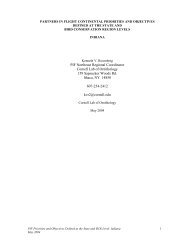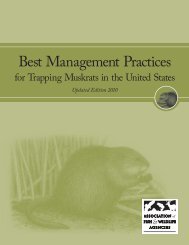Modern Snares for Capturing Mammals: - Association of Fish and ...
Modern Snares for Capturing Mammals: - Association of Fish and ...
Modern Snares for Capturing Mammals: - Association of Fish and ...
- No tags were found...
Create successful ePaper yourself
Turn your PDF publications into a flip-book with our unique Google optimized e-Paper software.
<strong>Modern</strong> <strong>Snares</strong> <strong>for</strong> <strong>Capturing</strong> <strong>Mammals</strong>:Definitions, Mechanical Attributes, <strong>and</strong> UseConsiderations…………………………………………………………………………………………………………………………INTRODUCTION<strong>Snares</strong> represent one <strong>of</strong> the oldest devices used <strong>for</strong> capturing animals. Their use dates backthous<strong>and</strong>s <strong>of</strong> years, as evidenced by their depiction in cave drawings. While some snares areconcealed under dirt or snow, snares are most commonly placed along existing animal travelroutes, or along the anticipated path <strong>of</strong> travel an animal may use when approaching bait or otherattractant. They can be, <strong>and</strong> historically were, designed or deployed to capture animals by theneck, torso, leg, or foot. While the basic principles behind snare use have changed little throughtime, the physical <strong>and</strong> mechanical options <strong>for</strong> snare design have greatly exp<strong>and</strong>ed, <strong>and</strong> snaresremain a popular capture device among licensed fur trappers, animal damage controlpr<strong>of</strong>essionals, <strong>and</strong> increasingly among wildlife biologists.Historically, snares were constructed <strong>of</strong> various plant or animal fibers, <strong>and</strong> lacked reliablemechanisms (i.e., locks) that not only allowed loop <strong>for</strong>mation <strong>and</strong> smooth loop closure, but alsoprevented the snare loop from easily re-opening once the animal stopped applying pressure. As aresult, snares either had to be tended with great frequency in order to dispatch captured animalsshortly after capture, or set in a manner that would facilitate rapid death (e.g., use <strong>of</strong> ‘springpoles’). Otherwise, live-restrained animals would frequently be able to break or chew throughthe snare <strong>and</strong> escape. With the advent <strong>of</strong> metal snare components (wire, locks, swivels, etc),both the efficiency <strong>and</strong> versatility <strong>of</strong> modern snares have improved. Users now have greaterflexibility to use snares as either live-restraining or killing devices, <strong>and</strong> a variety <strong>of</strong> options areavailable that can influence various per<strong>for</strong>mance attributes (injury reduction, rapidity <strong>of</strong> death,capture efficiency, selectivity, etc.).In spite <strong>of</strong> numerous improvements, laws <strong>and</strong> regulations in some states still prohibit use <strong>of</strong>snares, <strong>of</strong>ten dating back 50 - 100 years. Past concerns were frequently based on the belief thatsnares were highly effective but indiscriminate capture devices that allowed little user control <strong>of</strong>the capture outcome (e.g., live-restraint versus death). This led to concerns that snares could5Ver. 1.0
















